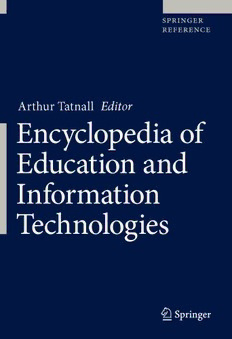
Encyclopedia Of Education And Information Technologies PDF
Preview Encyclopedia Of Education And Information Technologies
Arthur Tatnall Editor Encyclopedia of Education and Information Technologies Encyclopedia of Education and Information Technologies Arthur Tatnall Editor Encyclopedia of Education and Information Technologies With339Figuresand183Tables Editor ArthurTatnall VictoriaUniversity Melbourne,VIC,Australia ISBN978-3-030-10575-4 ISBN978-3-030-10576-1(eBook) ISBN978-3-030-10577-8(printandelectronicbundle) https://doi.org/10.1007/978-3-030-10576-1 ©SpringerNatureSwitzerlandAG2020 Thisworkissubjecttocopyright.AllrightsarereservedbythePublisher,whetherthewholeor part of the material is concerned, specifically the rights of translation, reprinting, reuse of illustrations,recitation,broadcasting,reproductiononmicrofilmsorinanyotherphysicalway, andtransmissionorinformationstorageandretrieval,electronicadaptation,computersoftware,or bysimilarordissimilarmethodologynowknownorhereafterdeveloped. Theuseofgeneraldescriptivenames,registerednames,trademarks,servicemarks,etc.inthis publicationdoesnotimply,evenintheabsenceofaspecificstatement,thatsuchnamesareexempt fromtherelevantprotectivelawsandregulationsandthereforefreeforgeneraluse. Thepublisher,theauthors,andtheeditorsaresafetoassumethattheadviceandinformationinthis bookarebelievedtobetrueandaccurateatthedateofpublication.Neitherthepublishernorthe authorsortheeditorsgiveawarranty,expressedorimplied,withrespecttothematerialcontained hereinorforanyerrorsoromissionsthatmayhavebeenmade.Thepublisherremainsneutralwith regardtojurisdictionalclaimsinpublishedmapsandinstitutionalaffiliations. ThisSpringerimprintispublishedbytheregisteredcompanySpringerNatureSwitzerlandAG. Theregisteredcompanyaddressis:Gewerbestrasse11,6330Cham,Switzerland Preface Computerstodayinvadealmosteveryaspectofourlivesandareusedinmany differentways,educationbeingnoexception.This,ofcourse,wasnotalways the case, and computers today are used in many different ways from the calculatingmachinesfromwhichtheyevolved.Thestored-programelectronic digitalcomputerfirstappearedinthe1940s,butcomputinggoesbackmuch furtherthanthisandcanbetracedtoearliertechnologiesincludingtheabacus, Antikythera mechanism (ancient Greek analog computer), Napier’s bones (logarithms), and Babbage’s difference engine that performed many of the mathematicaltasksnowperformedbycomputers.Fromamachinedesignedto perform calculations, the computer soon evolved into an information pro- cessing and communications machine that became indispensable around the world. University courses in computing began in many countries in the Depart- ments of Mathematics in the late 1940s. The question whether Computer Science was a branch of science, a branch of engineering, or whether it was something else entirely unique was long discussed, and it was not until the mid-1960sthatuniversitycoursesinComputerScienceasaseparatediscipline became widely available. Largely due to increased computerization of gov- ernmentdepartmentsandthegrowingcomputingneedsofbusinesses,inthe 1970suniversitycoursesinBusinessComputingbegantoappear.Thesesoon evolvedintowhatwenowcallInformationSystems.Today,universitycourses makeuseofcomputersinmanywaysinbothteachingandinresearch. Itwasinthe1970sthatschoolcomputingbeganaroundtheworldwhena smallnumberofschoolsinsomecountriesbeganusingsharedminicomputers along with punched cards for teaching programming in conjunction with facilities at local universities. This mostly related to mathematics, and the teachers involved were typically mathematics or science teachers who had done some computer programming in their university degree courses. The arrivalofrelativelylowcostmicrocomputerssuchastheAppleIIandTandy TRS-80inthelate1970smarkedthebeginningofthegrowthofcomputersin schools. In the 1980s, the curriculum of many schools included teaching Computer Literacy as well as some Computer Science. Computer use in subject areas followed with the use of databases, spreadsheets, and word processing. Perhaps the biggest innovation though was word processing, which was quickly adopted in many subject areas. Since then, the advent of the Internet, World Wide Web, Wi-Fi, Bluetooth, mobile computers, iPads, mobile phones, and social media has changed the face of educational v vi Preface computing out of recognition and led to the ways we use computers in educationtoday. Toconfusetheissue,therehasalwaysbeensomedebateaboutatitleforthis area:ComputerScience,Computing,InformationTechnology(IT),andInfor- mationandCommunicationTechnologies(ICT)arealltitlesusedbypeoplein differentcountries.InformationTechnologytodayisapproachedineducation in two different ways: teaching about computing in some shape or form (ComputerScience)ormakinguseofcomputersindifferentsubjectareas. Thisencyclopediacoversallaspectsoftheuseofcomputersandinforma- tion technology in every part and form of education. It covers aspects of teaching about computing and use of IT in many different subject areas. It coverscomputinginearlychildhoodeducation,computersinprimaryschools, computers in secondary schools, computer-related professional training and professionaldevelopment,computersinuniversities,andcomputersintrain- ingcolleges.Allchaptershavebeenpeer-reviewedbyatleasttworeviewers. ThetopicscoveredincludeITandlifelonglearning,assistivetechnologies for special education and people with disabilities, history of educational computing,ITeducationresources,educationalcomputergames,mobiletech- nologies,designingneweducationalproducts,innovationandadoption,com- puterscience,informationsystems,classroomcomputing,usingthecomputer as a teaching aid, teachers and IT, computing education research, online learning,globalpoliciesandissues,socialnetworking,digitalliteracy,educa- tional assessment using IT, educational management, ITissues in developed anddevelopingcountries,andsocioculturalissueswiththistechnology. Many teachers and academics have worked on writing chapters, and the encyclopediahasbeenassembledbyateamofSectionEditors.Theencyclo- pedia has contributions from authors from universities, schools, government departments,andinstitutionsinthefollowing46countries:Australia,Austria, Bahrain, Belgium, Canada, China, Colombia, Croatia, Cyprus, Denmark, Estonia,Finland,France,Germany,Greece,HongKong,India,Ireland,Israel, Italy,Japan,Kazakhstan,Kuwait,Lithuania,Macau,Malaysia,NewZealand, Nigeria, Norway, Oman, Poland, Portugal, Russia, Saudi Arabia, Serbia, Singapore, South Africa, Spain, Sweden, Switzerland, the Czech Republic, theNetherlands,thePhilippines,theUAE,theUK,andtheUSA. Ahardworkingeditorialteamhasbroughtthisencyclopediaintoexistence throughtheselectionofandinvitationtoauthorsandthereviewoftheirwork. TheteamconsistedofSigridSchubert(UniversityofSiegen,Germany),Eric Sanchez(UniversityofFribourg,Switzerland),JariMultisilta(TampereUni- versityofTechnology,Finland),ArthurTatnall(VictoriaUniversity,Australia), Vassilios Argyropoulos (University of Thessaly, Greece), Sam Goundar (Victoria University of Wellington, New Zealand), Don Passey (Lancaster University, UK), Bill Davey (RMIT University, Australia), Monique Grandbastien (Université de Lorraine, France), Tony Jones (University of Melbourne, Australia), Javier Osorio (Universidad de Las Palmas de Gran Canaria,Spain),FatenAbdel-Hameed(UniversityofBahrain,Bahrain),and JosephChao(BowlingGreenStateUniversity,Ohio,USA). Preface vii Thisencyclopediaaimstoofferteachers,scholars,parents,andthegeneral publicanindicationofthebreadthandimportanceofhowInformationTech- nologyisusedinallformsofeducation.Itillustratesthemanywaysinwhich ITisbeingusedineducation. VictoriaUniversity ArthurTatnall Melbourne,VIC,Australia May2020 List of Topics AssistiveTechnologiesforSpecialEducation CollaborativeLearningandPatternsofPractice andPeoplewithDisabilities Computer-AssistedInstruction,Changesin EducationalPracticeasaResultofAdoptionof SectionEditor:VassiliosArgyropoulos ICT AssistingPeopleWhoAreDeaforHardof Computer-AssistedLearning HearingThroughTechnology Computer-BasedLearning,Computational AssistingPeoplewithAutismSpectrumDisorder Thinking,andConstructionistApproaches ThroughTechnology Computer-BasedTrainingandSchoolICT AssistingPeoplewithPhysicalDisabilities Adoption,ASocioculturalPerspective ThroughTechnology DistanceLearning AssistingPeoplewithVisionImpairments E-BooksAmongStudents,Advancementsin ThroughTechnology HigherEducation AssistingStudentswithAttentionDeficit EducativeValueofDigitalStorytelling DisorderThroughTechnology EthicsandLearningforTeacherTrainees,Team- AssistingStudentswithIntellectualDisability BasedSimulationsinCasesofBullyingin ThroughTechnology School AssistingStudentswithLearningDisabilities FlexibleandDistanceLearning ThroughTechnology ICT-BasedInclusiveEducation AssistiveTechnologyandInclusion, Makerspaces PhilosophicalFoundation MobileLearningandUbiquitousLearning AssistiveTechnologyandtheGiftedLearner OnlineTeaching,Emotions,andEmoticonsin ITonTeachingandLearningProcessofVisually Computer-MediatedCommunication ImpairedStudents TeachingwithLOGOPhilosophy Technology-EnhancedLearning ClassroomUse ComputersinPrimarySchools SectionEditor: DonPassey SectionEditor:AnthonyJones BlendingLearningProvisionforHigher Education,Integrating“NewWays”of AlgorithmicThinkinginPrimarySchools TeachingandLearning CapturingLearningThroughMobileDevice BYODintheClassroom,Opportunities,Issues, Cameras andPolicies DesigninK-5ProgrammingProjects,Roleof ClassroomUse,BlendedLearning DigitalMediaBoardsinPrimarySchools,Useof ix x ListofTopics DigitalStorytelling,Information,andEducation eLearninginSaudiArabianUniversities,Toward ExploratoryStudyUsingSelf-RegulatedSelf- BlendedLearning Development(SRSD)andTechnologyinthe eXtremeModel-DrivenDevelopment ContextoftheClassroom (XMDD)TechnologiesasaHands-On SharedRegulatoryPlanninginMinecraft ApproachtoSoftwareDevelopment WithoutCoding FirstProgrammingLanguageinIntroductory ComputersinSecondarySchools ProgrammingCourses,Roleof GenderDifferencesinComputerScience SectionEditor:SigridSchubert Departments CompetencyModelsinComputingEducation IndicationsforKinestheticLearningThrough ComputationalThinking HapticDevices ComputersinSecondarySchools InformationandCommunicationTechnologies’ ComputingEducation,Practicesin PedagogicalAffordancesinEducation CurriculainComputerScience InnateAbilitiesandLearninginHigher InternationalOlympiadsinInformatics Education MobileComputingandMobileLearning InstitutionalRepositoriesVersusLearningObject Problem-SolvinginComputerScience,Learning Repositories,ChallengesandtheWayForward fromaGiftedPeer forHigherEducationalInstitutions ProgrammingandCodinginSecondarySchools KnowledgeEconomyofFacultyCompetenciesof ProgrammingLanguagesforSecondarySchools, IndianBusinessSchool Java LearningBehaviorsinProgramming ProgrammingLanguagesforSecondarySchools, LearningManagementSystems,AnOverview Python LearningProgramming,StudentMotivation ProgrammingMisconceptionsattheK-12Level LearningProgramming,SuccessFactors SocialMediaandNetworksasDigitalInstruction LearningStrategiesandAchievementofIT andLearningPlatforms StudentsinHigherEducation TeachingAboutComputing ModelingofGamesandGameStrategies TeachingwithComputing,EducationalGames ModelingofScientificWorkflows ValueofTeachingComputerScience PredictingICTSkillsandICTUseofUniversity Students PriorProgrammingExperienceofUndergraduate ComputersinUniversities(andotherHigher ComputingandEngineeringStudentsin Education) Ireland ProgrammingLanguageSelectionforUniversity SectionEditor:BillDavey Courses AffordancesofTechnologicalConnectivistTools ProgrammingLanguagesforUniversityCourses inHigherEducation SmartBoardTechnologyinHigherEducation AgileMethodologyinEducationofITStudents, Institutions Applicationof SoftwareDevelopmentProcessesDesignedfor AgileMethodsandTeamWorkinITEducation FirstYearComputingUndergraduates ApplyingSoftwareEngineeringPrinciplesin TabletUseinHigherEducation AndroidDevelopment TeachingComputerLanguagesinUniversities ArtComponentofRemoteTraininginRussian TeachingSoftwareDesignTechniquesin Universities UniversityCourses ClickerInterventions,PromotingStudentActivity Technology-EnhancedLearninginProgramming andFeedbackatUniversityLectures Courses,Roleof DigitalTechnologiesinHigherEducation, ValueofTeachingPRINCE2Project LearningChallenges ManagementMethodology ListofTopics xi ComputingEducationResearch DigitalLiteracy SectionEditor:MoniqueGrandbastien SectionEditor: JariMultisilta ComparativeAnalysisofE-GovernanceandIT DigitalLiteracy,Creativity,andAutonomous Governance Learning QualitativeMethods,LessonforInformation DigitalSimulationsinHealthcareEducation SystemsResearchers DigitalStorytellinginTeachingandResearch DistributedCollaborationinProject-Based LearningandItsAssessmentinNext- GenerationLearningEnvironments ComputinginEarlyChildhoodEducation LearningwithSimulationsinHealthcare PrimarySchoolClassroomWritingInterventions SectionEditor:AnthonyJones UsingTechnologies EducatorsandChildrenPerceivingAffordances Problem-BasedLearningOnline withWorkingTechnologiesinEarly TeachingandLearningComputationalThinking ChildhoodSettings andCodingSkills PositioningChildrenwithDigital InteractivetoEnableEarlyConceptual Learning EducationalAssessment SectionEditor: FatenS.M.Abdel-Hameed DesigningNewEducationalProducts E-PortfolioinHigherEducation InformationTechnologyandAssessment SectionEditor:ArthurTatnall WhatsAppforElectronicFeedbackand AdoptionofInnovativeICT-EnabledSystemsfor Assessment Analysis-andIntuition-StyledTeachersin PrimarySchools Bunyip,TheAustralianEducationalComputer thatWasNeverBuilt EducationalManagement InteractiveDisplays,UseofInteractiveCharts SectionEditor:JavierOsorio andDashboardsinEducation UsingSocialMediatoPromoteAcademic AttendanceRecords,EducationalManagement Functioning ComputersinEducationinDevelopingCountries, ManagerialIssues DataMiningforEducationalManagement DecisionSupportSystemsandKnowledge DevelopedandDevelopingCountries ManagementinEducation Human,Social,andEthicalAspectsof SectionEditor:SamGoundar InformationTechnologyManagement AdoptionofVirtualLaboratoriesinIndia, Systems LearningAssessmentsandRolesofICTSkill InformationTechnologyforLocalEducation LearningTools AuthoritiesandSchoolDistricts,Useof BuildingRuralRenaissanceandSuburban ITinEducationalInstitutions,Planningand DevelopmentwithInteractiveTechnology Developmentof SolutionsinIndia SchoolManagementSoftwareinaPrimary SafeFrames,EssentialDeterminantfor SchoolinVictoria,Useof EducationalTechnologyImplementationinan SecurityandPrivacyofInformationTechnology IndigenousContext ManagementSystems
